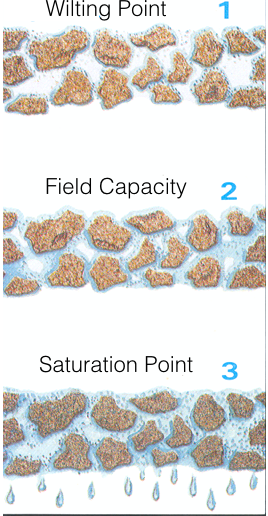The amount of plant available water in bowling greens is determined by the texture and structure of the rootzone soil. In our recent investigation into soil texture in bowls green maintenance we saw how the Particle Size Distribution within the soil (rootzone) can determine the soil’s porosity or air space. Having determined that the ideal rootzone will be 50% space, we then saw how soil porosity is split into two main types, namely Macro Porosity; the large spaces between soil particles responsible for drainage and aeration, and Micro Porosity; the smaller spaces between soil particles that are largely responsible for water and nutrient retention.
Meso-Porosity
We also saw in an earlier article, the need for water to adhere to soil particles in order to stay available to plants. This brings us to a further split in Soil Porosity types. The Micropore space is actually broken down into two types of soil porosity called Micro and Meso Porosity. the word Meso comes from the Greek and roughly translates as middle; so we now have small (micro), medium (meso) and large (macro) pore spaces in the soil to think about.
The Mesopores are where most of the plant available water is held, whilst the very smallest Micropore spaces directly adjacent to the soil particle surfaces, usually hold water too tightly (due to surface tension) for plant roots to extract it.
Stages of Saturation in Bowling Green Soils
Imagine for a moment that your bowling green has just had a thorough soaking due to a heavy thunderstorm. Eventually, there will come a point in the deluge, when the green can take no more and puddles start to appear on the surface. When the rain stops, we will normally see the rootzone go through 3 stages of wetness.
1. Saturation Point
This is when all of the soil pore spaces (macro, meso and micro) are filled to capacity with water. In a well structured soil, this stage will be short lived as gravity will start to pull the water out of the macro pore spaces in the soil. Incidentally, the USGA golf rootzone specification lays down parameters for the speed of drainage from 150mm (6″) to 600mm (24″) per hour. The specification of the rootzone is altered to achieve this depending on the expected precipitation in the location that the green is being built in. Imagine that for a minute; these rootzones can be engineered to get rid of 2 feet of water in 1 hour!
2. Field Capacity
This is when all of the macro pores have been drained by gravity and the micro and meso pores remain full of water. This is the desired state for optimum plant growth. In this state, the soil contains the maximum volume of plant available water and of course we know that the soil water also contains the essential nutrients needed by the grass plants to build plant tissue.
Even very fast draining soils can remain at field capacity with no danger of gravity drying them out as the surface tension of the water when it is in these smaller pore spaces ensures that it stays adhered to the soil particles. This surface tension in this case is stronger than the pull of gravity.
However, as plants take up the available water to go about their everyday business of photosynthesising, respiring and growing, they use up the available water and lose a lot of it to the atmosphere through transpiration. Water also evaporates from the soil when the sun heats the surface of the green. The combined effect of these losses is called Evapo-Transpiration; literally a mix of evaporation and transpiration. In very broad terms this is likely to amount to about 25mm of water loss per week in a typical summer in the UK and a lot more in a very warm, dry spell.
In practice it is usual for bowling greenkeepers to try to maintain their rootzones in a state that is slightly below Field Capacity. Any point below Field Capacity is termed a soil moisture deficit (SMD) and turf managers might use a Water Balance Sheet (explained in Performance Bowling Greens) to monitor and maintain a pre-defined soil moisture deficit, usually specified in millimetres. For example if the Water Balance Sheet shows SMD of 6mm, the greenkeeper might only replace half or two thirds of that through irrigation to maintain SMD of 2 or 3mm. The benefits of this include the encouragement of the fine grasses to put down deeper roots and the stressing of shallow rooting weeds and weed grasses like annual meadowgrass.
3. Permanent Wilting Point
The final stage is called Permanent Wilting Point for obvious reasons. This is when the only water remaining in the soil is so tightly bound to soil particles by surface tension and in the very smallest of the micropores that it is essentially unavailable to plants. At this stage plants will start to show signs of wilting. The plant tissue will become flaccid and soft due to the plant cells drying out. The grass plant will have closed its leaf stomates to reduce losses to transpiration causing it to start using Oxygen instead of CO2 in a process called Photorespiration (roughly speaking, a wasteful form of Photosynthesis).
Conclusion
Now you should be better equipped to manage the water in your green. Tracking water inputs from precipitation and irrigation is important in bowling green maintenance, in order to ensure there is always sufficient moisture available to your turf to keep it growing healthily.
Soil water and porosity knocks on to another key subject area in greenkeeping you’ve no doubt heard of: Compaction. We’ll look into that next time.


